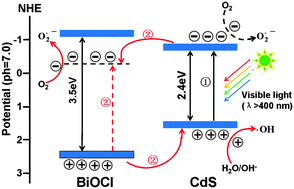Efficient visible light photocatalytic activity of CdS on (001) facets exposed to BiOCl†
Abstract
Cadmium sulphide (CdS) quantum dots (QDs), sensitizing hierarchical bismuth oxychloride (BiOCl) photocatalysts, were synthesized via a facile solvothermal approach and characterized in detail. The as-prepared CdS–BiOCl photocatalyst possessed an extended light absorption range and efficient charge separation properties simultaneously compared with pure BiOCl, especially in the visible light region. The results revealed that the newly formed oxygen vacancies will play an important role in the visible light degradation process, which resulted in the efficient separation of photogenerated electron–hole pairs, and a large increase in photocatalytic activity.


 Please wait while we load your content...
Please wait while we load your content...